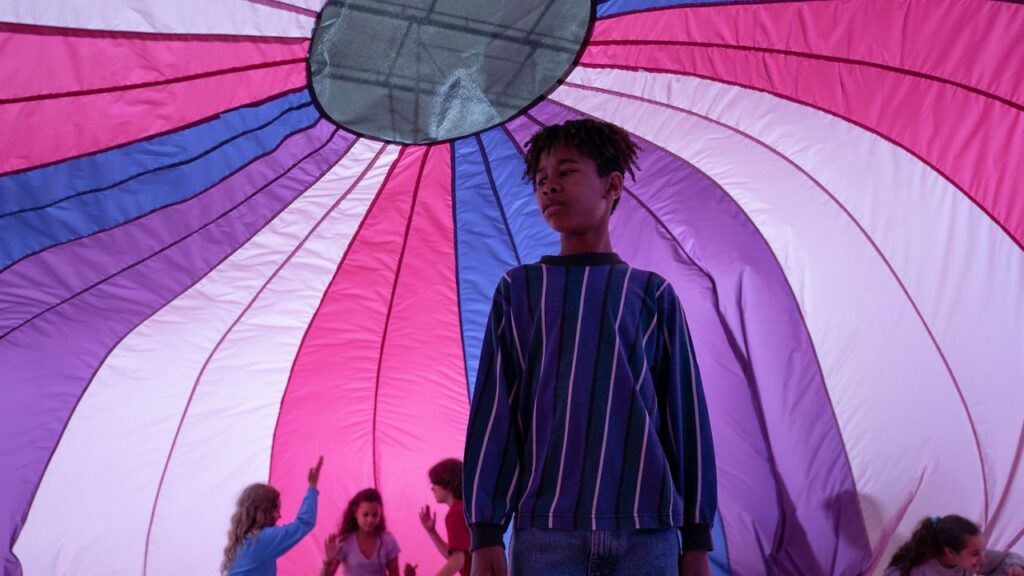A wiser man than I once said that without heart there can be no art. By this barometer, Jane Schoenbrun’s arthouse curio I Saw the TV Glow is hardly the instant masterpiece it’s been inexplicably ordained. The picture may be a conceptual thesis—but it definitely isn’t art. Its tale of a pair of 1990s’ teens entranced by a TV phenomenon is ambitious to be sure, but also mannered and dispassionate in ways that prevent engagement. Despite an innovative visual design, Schoenbrun’s chilly second feature (after 2021’s Let’s All Go to the World’s Fair) demands significant investment while offering far less enlightenment.
On the cusp of adolescence, shy seventh-grader Owen (Ian Foreman) finds solace in a budding friendship with the older, enigmatic Maddie (Brigitte Lundy-Paine). Both outsiders in their own right, they form an unlikely bond. Owen is a hushed, timid loner close to his mother (Danielle Deadwyler), while Maddie is an alternative-goth high schooler whose world revolves around the cult TV show The Pink Opaque, a creepy girl-power mystery series blending elements of Buffy The Vampire Slayer with the tonal absurdity of Mighty Morphin’ Power Rangers.
Maddie, recognizing a kindred spirit in Owen, devises a clandestine plan to introduce him to the allure of The Pink Opaque, knowing his strict parents forbid him from staying up late to watch. Thus unfolds a series of secret basement sleepovers, their budding friendship intersecting with the mystique of the late night show. The scheme unfolds flawlessly, reeling in Owen and Maddie with equal fervor for the addictive charms of the show.

Time passes and while Maddie proclaims her queer identity, Owen (now played by by Justice Smith of Dungeons and Dragons: Honor Among Thieves) wrestles with a deeper yearning, a hunger for self-discovery that seems perpetually out of reach. Sensing this, Maddie leaves an indelible mark—the secret symbol of The Pink Opaque‘s heroines—etched onto Owen’s neck, as if branding him with a sense of longing and belonging. The problem begins when the pair become so enraptured by the show that they can no longer distinguish reality from art; it’s almost as if they’d prefer to live inside the show and ultimately become unable to separate the two. Schoenbrun and cinematographer Eric Yue shuttle the film between both realms and the effect is that of a waking nightmare; an escape but one fraught with paranoia.
While Maddie plots her grand escape from the suffocating confines of the town, Owen’s story takes a darker turn. Left to grapple with the untimely loss of his mother, he finds himself shackled to an abusive stepfather (played by none other than Fred Durst) and a mundane job at the local cinema. Yet, even amidst his grim reality, Owen remains haunted by vivid dreams of the show, now canceled.
The film is purportedly a symbolic exploration of the consequences of suppressing a transgender identity—if you say so. Many have also drawn parallels to David Lynch’s Twin Peaks, highlighting Schoenbrun’s adept portrayal of eerie small-town atmosphere, capably mounted. Its strongest suit is in its stylistic flourishes, evident from the juxtaposition of vibrant sidewalk chalk against the darkness of night in the opening shot to its dreamlike, neon-fueled nightmares.
For cinephiles and many LGBTQ+ audience members the notion of childhood media representation will resonate. Ask many a gay man of his formative adolescent fascinations and he will point to powerful media images of strong women and virile men, speaking directly to him in a language not heard by others. For Owen and Maddie, The Pink Opaque is a hypnotic respite, a reactor, a catalyst; yet Schoenbrun plays too close to the vest with each character and refuses to excavate, more concerned with mood and tone than allowing us access to their humanity.

Despite Schoenbrun’s vocal emphasis on the transgender identity narrative, which remains largely peripheral save for a fleeting dress-up montage and a metaphorical closing sequence, the director fails to sufficiently flesh out or humanize the characters. Maddie is written as a familiar movie rebel, expressing desires for escape before reappearing in a state of paranoia, while Owen, portrayed as a socially isolated youth, lacks clearly defined psychology. Neither is engaging.
Consequently, we are left to decipher Owen’s motivations amidst Schoenbrun’s detached and stylized approach, characterized by abstract imagery such as burning televisions, obscure VHS recordings of the show and numerous shots of star Smith, whose wide-eyed expressions render him largely inscrutable and frustratingly elusive, which is perhaps Schoenbrun’s point but a miscalculation for a lead character required to carry a film.
A24 is marketing I Saw the TV Glow as an horror-coming-of-age-identity something or other while the film’s notices largely cite its directorial distinctiveness as a mark of high originality. Fine. Really, there are just two good and true ideas here—the powerful impact of pop culture constructs that communicate, almost in code, to the secretly forming identities of queer adolescents in dire need of identification in a world sans representation; and that an inability to live one’s truth—whether seeking independence, questioning orientation or experiencing gender dysphoria—can lead to a protractedly miserable existence. Understood. But the film those ideas are buried (too deeply) within simply isn’t compelling.
In its closing moments, the thematic essence of the film achieves a too late clarity as Schoenbrun dramatically ages actor Smith by decades, offering an efficient visual commentary on the profound toll of repression. Yet, despite these moments and its occasionally arresting visual style, I Saw the TV Glow is hollow at its core; Owen’s sense of emptiness finds a mirror in his director’s picture, which is a sluggishly paced chore. Where’s the remote when you most need it?
2 stars (generously)




An enchanting portrayal of aesthetics overshadowing depth. ‘The TV Glow’ delves into the allure of surface allure amidst themes of obsession and repression.
Thanks for the comment, Rick!
Captivating visuals mask a narrative lacking depth. Style dazzles, but substance falters in this tale of obsession and repression.